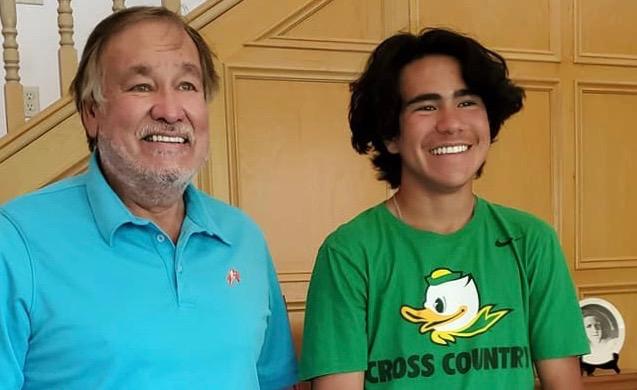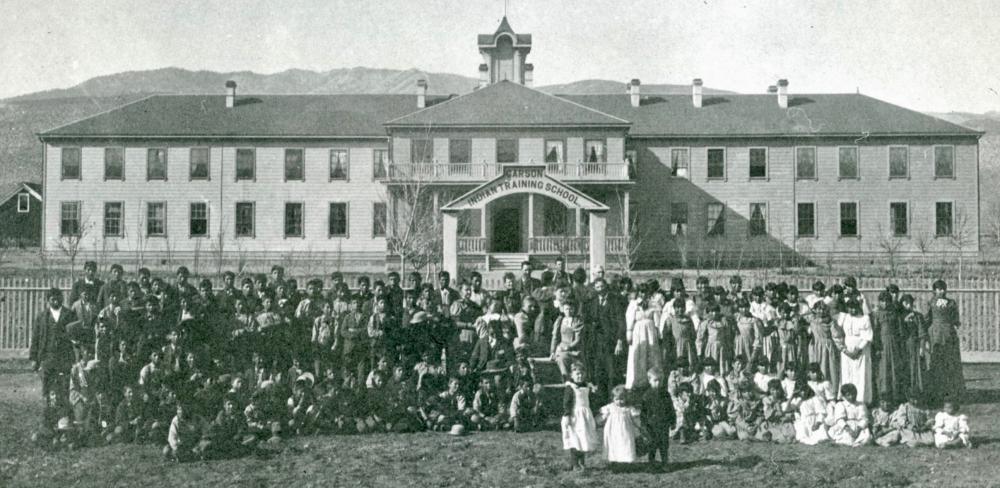Folders |
Running Away Home: Ku Stevens In The Footsteps Of A MemoryPublished by
Running Away HomeKu Stevens retraces his great-grandfather’s escape from Stewart Indian SchoolA DyeStat story by Dave Devine _____________ “The majority of children at Stewart were young, unwillingly taken miles and miles from their homes, and transplanted to another world with little contact with home, family, and culture.” - The Student Body: A History of the Stewart Indian School, 1890-1940, Bonnie Thompson _____________
Summer in western Nevada. A parched, furnace-blast wind — 104 degrees. Brass sky. Heatwaves blurring the horizon. Stepping outside, like opening an oven door. And Kutoven “Ku” Stevens is out running in it. He doesn’t have much of a choice, it’s almost time for his shift at the supermarket. And he knows he’s cutting it close, but he tries to run when it’s as hot as possible. He craves the callousing effect of the heat, how it makes him tougher at the end of races. And he’ll follow that up with nine hours at Raley’s supermarket in Yerington. How many kids are doing that? Eight-mile run followed by a nine-hour shift. He’ll split his time between bagging groceries and stocking shelves. Some of the shoppers will recognize him, they almost always do. It’s a small town, just off the Yerington Paiute Reservation where Ku lives with his parents, Delmar and Misty. People know each other. Maybe they recognize him from the newspaper articles about his exploits on the track. Or their kids go to high school with him, where he was just the junior class president. Or they’ve seen him out running, sunglasses and visor loping along the reservation roads. That’s the most likely possibility. For as long as he can remember, he’s been that guy — the kid who runs. As a young boy, a lean middle schooler, the high school star — always the one with the short shorts and the smooth stride, drawing taunts from passing pickup trucks: Put some clothes on! Run, Forrest, run! But it’s become an identity for him, a way to carve out a name. Ku, the kid who runs. The kid whose feet might take him somewhere. The one who kept up with the Yerington High varsity squad as an eighth grader. The high school junior who competed as a one-man cross country team last spring and went undefeated through a COVID-shortened season. Caught the attention of Runner’s World and ended up featured in an article. Took a spring break trip to Eugene, Ore., with his parents to visit the University of Oregon — his dream school — and bumped into decathlon all-timer Ashton Eaton. Ran on Pre’s Trail. Tried to convince a security guard to let him sneak into Hayward Field. Got invited to meet Billy Mills, perhaps the greatest Native American runner of all time. And then sat rapt in Mills’ living room as the stories bubbled out. Held the weathered spikes from Mills’ 1964 Tokyo Olympic race. Ran at the Golden West Invitational and won his 3,200-meter race by 20 seconds — in front of Mills, who’d come to watch. And then had breakfast afterward with the legend. A crazy few months. Sometimes, it all leaves his head spinning. “Honestly, my running career had been pretty limited to Yerington, Nevada,” he says. “Like, the biggest race I’d done before this year was probably a 5k in Reno.” In the next two weeks, he’ll compete in the USATF Junior Olympic Championships and the AAU Junior Olympic Championships. WATCH THE USATF JUNIOR OLYMPIC CHAMPIONSHIPS JULY 26-AUG 1 ON RUNNERSPACE +PLUS All the while, he’s preparing for the start of a promising senior year. Banking miles and bagging groceries. He can feel, in a visceral way, the once-narrow boundaries of his world beginning to yawn open, can glimpse opportunities and distant starting lines just past the horizon. But even as he begins to apply to schools hundreds of miles away, he can’t stop thinking about a school 50 miles up the road. And as he trains for the upcoming season, he can’t shake the thought of another boy whose feet also took him across this parched land. A boy who ran, not in pursuit of distant horizons, but simply to get back home.
Togo’o There were two wood-burning stoves. Delmar Stevens, Ku’s father, remembers that detail about his grandparents’ home. “One to heat the house and another to cook on,” Delmar recalls. “So, it was a lot of wood.” As a teen in the 1970s, he would cut, stack and restock that wood. “Always chopping and hauling it for them,” he says. Frank and Hazel Quinn were Delmar’s maternal grandparents. They lived just up the road on the reservation; he knew them as Granny and Togo’o. “In Paiute, we refer to him as Togo’o,” Delmar says of Frank Quinn. “Togo’o means ‘grandfather on your mother’s side.’ So that’s what we all called him.” But years before everyone affectionately knew him as Togo’o, when Quinn was himself just a child, he endured a fate that countless Native and Indigenous children around the world have experienced. Seized by government officials, he was forced to attend a boarding school, far from home, with the express purpose of assimilating and “civilizing” Native children into white society. In Quinn’s case, he was taken from his Northern Paiute family at the age of 8 and sent to Stewart Indian School in Carson City, Nevada. That school was part of a nationwide residential program that began in 1879 with the opening of the U.S. Indian Industrial School at Carlisle, Pennsylvania, under the leadership General Richard Henry Pratt. Pratt’s philosophy for cultural assimilation was summarized in a line from a speech he gave in 1892: “Kill the Indian in him, and save the man.” Stewart opened as a boarding school in December 1890 with an initial student body taken from the Washoe, Western Shoshone, and Northern and Southern Paiute nations. Eventually, more 30,000 students from nearly 1,000 tribes attended the school during its 90 years of operation. There were rudimentary classes in reading and arithmetic, but the primary focus was on vocational training. For boys, that meant agriculture, mechanics, woodworking and carpentry. By design, students provided most of the labor for the daily functioning of the school. After being abducted, Quinn would have had his hair cut, been sprayed down and washed in lye, had his given name changed, issued a school uniform, and been forbidden to speak his native language. The objective was to strip away any vestige of tribal culture. At some point, Quinn — still only 8 years old, likely terrified and confused — attempted what many children did in the long history of the school. He ran away. He traveled more than 50 miles through the desert mountains to his family’s home near Yerington. That freedom was short-lived, however. Quinn was soon recaptured by government officials and returned to the school. In family stories handed down, Delmar has been told that his grandfather ran away from Stewart three times, each time covering the rugged landscape alone and on foot. “And after the third time,” Delmar says, “the family probably got pretty good at hiding him, knowing that the government was going to come again. I don’t think he went back after that.” Delmar’s maternal grandmother, Hazel, was never abducted. “Her family hid her every time the government was looking for her,” he says. As Delmar grew older, eventually raising his own children, the stories about Togo’o and the escapes from the Stewart Indian School were woven into the fabric of family history. Always present, occasionally discussed, but rarely shared as a singular focus. Ku can’t recall a specific time, or one weighty conversation, when his father sat him down and told the story. “It’s just something that gets mentioned sometimes,” he says. Likewise, the Stewart school didn’t exist in Ku’s imagination as a cautionary tale or some menacing campus with a notorious reputation. It was actually home to a gymnasium where he played basketball growing up. “I played rez ball since like first grade,” Ku says, “and we would have tournaments over at Stewart. I think that’s probably when my dad was like, ‘Your great grandfather, he went here.’ It just kind of stuck with me.” As he’s learned more about the U.S. government’s treatment of Native communities through history, Ku’s understanding of those family stories and their connection to that school in Carson City has deepened. “As a kid,” he says, “I didn’t understand the gravity of what it meant to go to a boarding school. Now that I’m older…you understand what was at stake.” He’s spent time, especially recently, imagining what those stolen children must have experienced. What they lost, how urgently they missed their parents. How desperately they longed to go home. “They just wanted to be with their families,” Ku says, “no matter the cost. They knew if they were caught, or if the government came to their house and found them again, they were going to be taken back and essentially just…broken. That was the intention, to break them. To break their spirit and take away their culture.”
Kutoven When Misty Stevens was pregnant with her son, she had a dream about the child she was carrying. “He came to me, and told me who he was,” she says. The dream was so vivid, so unshakeable, that she and Delmar took the vision to a respected elder on the nearby Walker River Paiute Reservation in Schurz, Nevada. “We described the dream,” Misty recalls, “and he came up with this word that combines everything that happened in that dream.” That word — Kutoven — became their son’s name. It means: The one who brings the light from the darkness, as the eagle brings the dawn from the night. “It’s kind of long,” she says, “but that’s what it means.”
“Ku mostly grew up as an only child,” Misty says. His connection to running started early. Delmar, an avid runner, began pushing Ku in a jogging stroller before his son could walk. It wasn’t long before the toddler was begging to join his father outside the stroller. “He’d run a little bit,” Delmar recalls with a laugh, “get back in the stroller, then run a little more…” The first time Misty and Delmar really saw Ku race was at a holiday “Jingle Bell Run” in the reservation town of Schurz, the same place where they’d received his name. Race organizers hosted a half-mile fun run for kids. Ku ran with Mia, one of Delmar’s daughters. “He sprinted the whole dang thing,” Delmar remembers. “That was his first race, and he hasn’t looked back…He knows like, one gear: fast to faster.” Ku has made steady progress in the sport ever since, from an eighth grader training with Yerington's high school team to a top-five finisher in the 1,600- and 3,200-meter races as a freshman at the 2A state meet. His sophomore campaign began with a promising, third-place finish at the state cross country championships before COVID derailed the track season in March of 2020. At that point, nearly everything on the reservation was shuttered. It could have easily left a frustrated teenager drifting, but Ku approached the quarantine with a sense of purpose. When the school district provided students with a laptop loaded with work to carry them through the remainder of the semester, he completed the assignments in a few weeks. “Then he was kind of bored,” Misty says, “and we were looking at months at home, so he said, ‘I’m gonna go get a job.’” He applied at Raley’s, the main supermarket in Yerington. “I’m supposed to be a bagger,” he says, “but they know I’m a hard worker, so I usually stock things — milk, beer, 35-packs of water — the heavier kind of stuff.” He also built a chicken coop for Misty. Refurbished a bench. Repaired a light post, painted the porch. “He kept himself busy,” Delmar says. And, of course, Ku ran. Due to pandemic restrictions, his junior-year cross country and track seasons were both contested this past spring, without a state meet in either sport. Ku had no teammates for cross country, so he mostly coached himself through an undefeated March/April season as Yerington’s sole harrier, claiming a convincing win at the 2A Northern regional. Track season began much the same — Yerington’s team was more sizeable, but Ku still struggled to find training partners to push him. And then a coach in Reno, who had seen Ku at several meets and read an article about his solo cross country season, reached out with an offer of help. “I met Lupe Cabada towards the beginning of the (track) season,” Ku says, “maybe one or two meets in, and he started coaching me.” Cabada, Misty notes, has since become more than a coach. “He’s really a mentor,” she says. “He’s letting us know about all these things that we should be doing.” With Cabada’s encouragement, Ku qualified at regional meets to compete in both the USATF Junior Olympic Championships in Jacksonville, Fla., and the AAU Junior Olympic Championships in Houston, Texas. “We’re just now hearing of things like AAU and USATF,” Misty says. “We haven’t competed there because we haven’t had the guidance. We’re a little bitty town, and we just didn’t know about things like this.” On Wednesday mornings, Ku drives to Reno to work out with a group of runners Cabada trains. The other days, he’s typically on his own. “But you don’t have to tell Ku to go out and run,” Delmar says. “You don’t have to remind him, ‘Hey get your shoes on,’ — that’s all him. In fact, sometimes Coach Cabada says he has to hold that boy back, because he always wants to do more.” Tamakoce Te’Hila It’s the kind of connection that could only have happened in the social media age. A post. A tag. Direct messages and found phone numbers. After Ku’s regional cross country victory, Misty posted an article link to her Facebook page. A relative of the legendary Olympian, Billy Mills, tagged him in a comment. Mills’ wife, Patricia, saw that tag and somehow tracked down Misty’s phone number. “We were sitting here in the living room one night,” Misty recalls, “and his wife called us up. She said, ‘Billy would like for Ku to come and visit him. Do you think you could make some time?’” Ku could hardly believe his ears. Mills, of course, was the gold medalist for the United States in the 10,000-meter run at the 1964 Tokyo Olympics. His heroic, unexpected charge to the line was immortalized by American broadcaster Dick Bank’s rapturous interruption of the race call: “Look at Mills! Look at Mills!” Raised on the Pine Ridge Reservation in South Dakota, Mills, now 83, is a member of the Oglala Lakota (Sioux) tribe and was given the Lakota name Tamakoce Te’Hila, which translates to “respects the earth.” Orphaned at the age of 12, he, too, was sent to a residential boarding school, enrolling at the Haskell Institute when he was 15 years old. There, Mills began the running career which eventually took him to the top of the Olympic podium. Almost 56 years later, when the Stevens family drove to Sacramento, Calif., to meet with him, they expected to spend perhaps 30 minutes with Mills — about the length of that gold-medal run in Tokyo. Instead, the visit lasted more than two hours. Mills shared stories and passed along advice. He listened as Ku spoke of his own efforts and aspirations. Brought Ku to a wooden cabinet that contained the Tokyo gold medal, the Team USA singlet, and his spikes from that momentous race. “It was definitely an experience meeting him,” Ku says, “I’ve idolized him since I was a kid.” Two months later, when Ku raced at the 61st Golden West Invitational, Mills was there to watch. Ku didn’t disappoint, placing third in the mile with a new personal best of 4:19.28, then running away with the 3,200 in 9:20.62 — his second PB of the meet. Afterwards, Mills joined the family for breakfast. It was another opportunity for stories and connection. Another unexpected moment with an Olympian. But for Misty, the long afternoon in Sacramento left the deepest impression. “We were sitting in his house and he was telling us the story of (the Olympic 10,000-meter victory), everything that was going through his head,” she says. “But when we left, all I could think about was what a great humanitarian this man is — everything he did after the Olympics with his life.” Nobi mea-kwu Even before the news emerged from Canada, Ku had considered a run to honor his great-grandfather. He and his dad had been mulling the idea of retracing Quinn’s run as a way to remember that journey. They’d completed other prayerful runs together in the past — multi-day efforts with a Native group called Peace and Dignity Journeys. This distance, split into two days, didn’t sound especially daunting. But it still existed as more of an abstraction than a plan. And then came the grim discovery of 215 unmarked graves containing the remains of Indigenous children at a former residential school in British Columbia. “That’s when we began to set things in motion,” Ku says. “I guess you could say that’s when the penny dropped, because that’s when we started making our moves.” A month later, news of an astonishing 751 additional unmarked graves at a different residential school in Saskatchewan only amplified the horror. Ku began preparing in earnest, mapping out a route from the Stewart Indian School to the Yerington Paiute Reservation. Not Quinn’s exact path, of course — it would be impossible to know how the 8-year-old found his way through the mountains all those years ago — but an approximation. A 50-mile, two-day journey with a night of camping and storytelling in between. Dirt roads and rugged backcountry. A way to honor and remember. Over Memorial Day weekend, the Stevens family drove out to the Stewart Indian School site to research and plan the run. Several of the original campus buildings have been converted into a museum and cultural center, with exhibits and displays that capture, in candid ways, the history of the school. For Ku and Delmar, it was a chance to think about how those buildings cut through their collective memories. How the school existed in different ways for different generations. A basketball court hosting tournaments for Ku and his buddies. A venue for boxing matches when Delmar was a teenage boxer in the 1970s: “They had a gym with a ring that they called ‘Moccasin Square Garden.’” But for Delmar’s grandfather, and so many others, a place indelibly linked to loss and fear. “In those days, it was the government’s attempt to erase the Indian,” Delmar says. “They took away our kids, with the intent of stripping away their language, taking their hair, beating them, sexually molesting them…on and on. It was horrible.” On the drive home, as Ku watched the landscape reel past, he sat with that complicated history, attempting to center his great-grandfather in all of it. “Being a runner,” Ku says, “you want to scout out your courses before you run them…But this one was a bit different. I kept thinking, ‘Man, there’s no way an 8-year-old could’ve done this.’ But he did. Three times. It’s crazy to think about.” When he thinks ahead to the run now, he’s more concerned about the heaviness of memory than the challenge of the miles. “The run won’t be the hard part,” he says. “Pain is a concept of the mind, and the real pain comes from the heart, that’s what I believe. You have physical pain, but you can work through that, you get over things like that. But the pain in the heart — that stuff lingers and stays and dwells.” Misty has handled much of the planning and logistics via a Facebook page. As news has spread — again, mostly via social media — the response has been staggering. Messages and notes have poured in from Native communities throughout the Southwest and beyond, many with personal stories of relatives who ran away from residential schools. Some, with heartbreaking accounts of ancestors who never made it home. Donations and offers of support arrive daily. What began as a small, family-sized effort has evolved into something much larger. There are event sponsors, meal providers, donated Port-a-Potties, a growing number of people, from far and wide, who have said they plan to walk or run along with Ku. It’s been named the Remembrance Run, scheduled for August 13-15. There’s a t-shirt created by a local graphic designer with a silhouette of Ku on the front and a Paiute phrase featured prominently: Nobi mea-kwu. “Nobi is ‘house.’ Or home,” Delmar explains. “Mea-kwu is ‘going.’ So, a translation is, ‘I’m gonna go home now.’” It’s meant to convey the decision that a young child — scared, lonely, terrorized, homesick at a school he’s been forced to attend — might reach before fleeing into the desert. I’m gonna go home now. When Ku articulates his intent for the run, he emphasizes a focus on memory, education and healing. “We’re not trying to shove the past into somebody’s face, saying ‘This is what your ancestors did to my ancestors,’ it’s not about that,” he says. “It’s about remembering. And giving recognition to the people who lost their lives, escaped, lost their culture, their hair, their language — all of that.” Misty says it’s understandable, especially in the wake of the discoveries in Canada, that the focus on residential schools will expose a range of emotions. That some might bring anger to their participation, or feel called to protest the dark history of the schools at Ku’s event. “But I’m trying to keep everybody on the same path,” she says. “Ku has a picture in his head of how he wants it to go, and I’m trying really hard to keep that picture in my head, too, and not let it shift from the original vision.” Delmar describes it as using their legs in a prayerful way. Misty says, whether someone is running or walking, they’ll be laying down prayers with their feet. It’s a chance to remember the past, surely, but also to celebrate the resilience of Native peoples. A chance for Ku to take another step forward in his own journey. For “the kid who runs” to bring home, one final time, the boy who ran. Closing the loop. Circling, like so much of life, back to the beginning. A dream. An elder. A succinct name with a layered, intricate meaning: The one who brings the light from the darkness as the eagle brings the dawn from the night. “It is a big name,” Misty acknowledges, “but he carries it well. There have been influences in his life that have wanted him to walk down that darker path with them, and he just won’t do it…He does bring the light to a lot of people. I hear that all the time.” More news
1 comment(s)
|

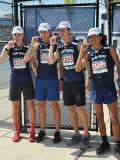













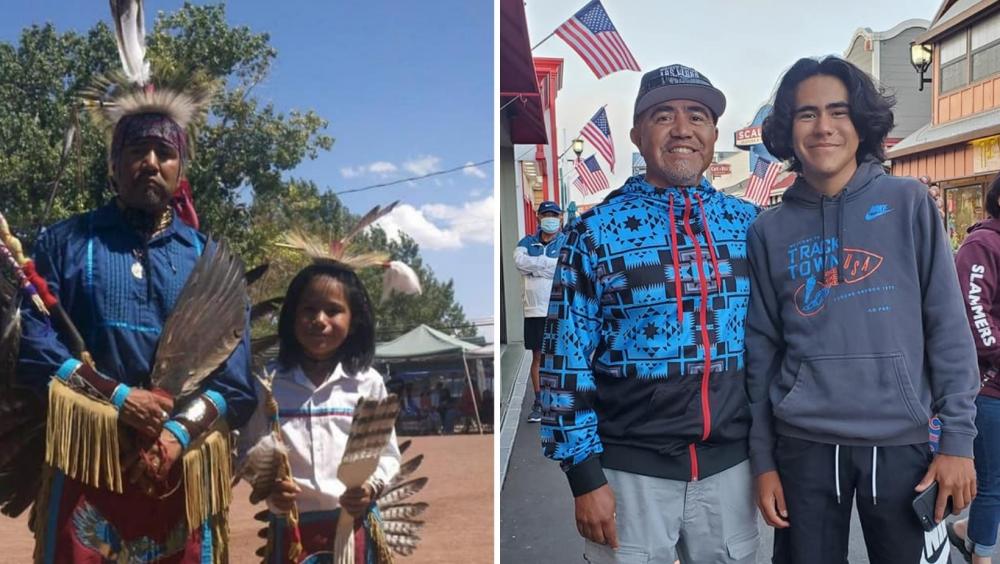
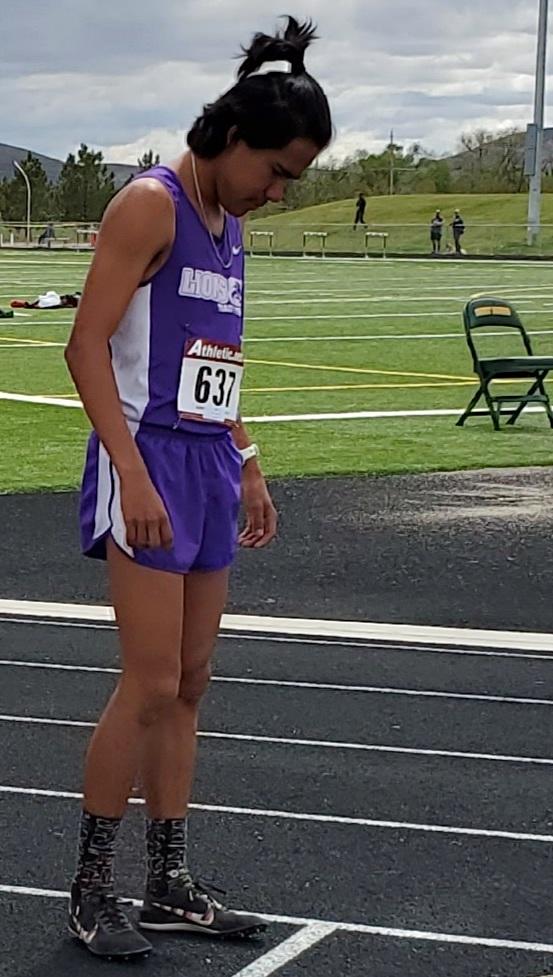 Delmar had four other children, three daughters and a son, all older and living out-of-state by the time Kutoven came along.
Delmar had four other children, three daughters and a son, all older and living out-of-state by the time Kutoven came along. 